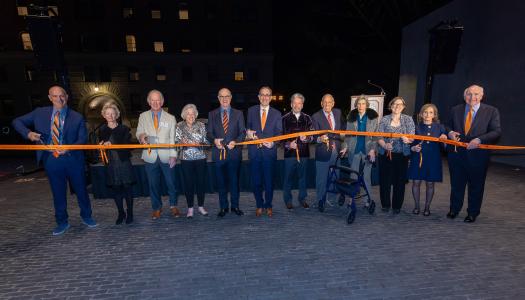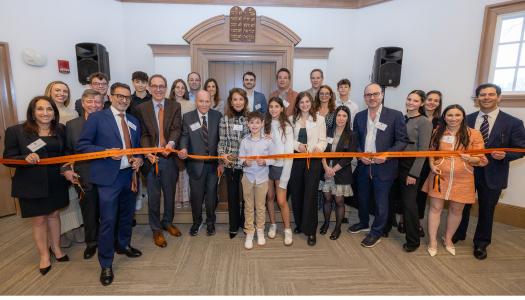Students in Butler College returned to campus to find sparkling new dorms and gracious new landscaping this fall, when the last of the University’s planned four-year residential colleges opened in time for the start of classes.
The new dorms include Wilf Hall, donated by the family of Mark Wilf ’84 and his wife, Jane; Bogle Hall, given by John C. Bogle ’51; Yoseloff Hall, given by Anthony A. Yoseloff '96, and his wife, Nanar; and Class of 1967 Hall, funded by a coalition of members of the Class of ’67, led by Class President John H. Laporte Jr. and University Trustee Emeritus John O. Wynne.
“Butler College’s new dormitories are a beautiful addition to our campus,” said President Shirley M. Tilghman at the dedication ceremony on September 24. “Not only do they greatly enhance the residential experience of our students, but they also mark the completion of Princeton’s four-year college system. I am deeply grateful to the many donors, past and present, who have brought us to this moment.”
Private and shared spaces
Butler College houses 288 undergraduates and graduate students, as well as a resident faculty member. Most rooms are four-person suites with two bedrooms that share a living room and bathroom. Each dorm also has kitchen facilities, as well as lounges for study and relaxation.
The dorms are connected through the central Butler Commons, which includes the James S. Hall ’34 Memorial Gallery and a food emporium, Studio ’34. The light-filled space is further enlivened by a colorful, multi-level mural designed by Nigerian-born artist Odili Donald Odita. On the same floor as the commons are study areas, a computer room, seminar rooms, and a lecture hall.
The commons open directly onto Butler Memorial Court, a terraced amphitheater at the heart of the college bordered by sloping lawns with arching ferns and lacy larch trees. Designed to accommodate both individual gatherings and performances, it honors the Classes of 1922, 1940, 1941, and 1942 for their generous support of the original Butler College. Another of the original Butler dorms is commemorated in Lourie-Love Walk, the north-south artery of the college.
Distinct architectural identity
The new Butler College blends into its neighborhood while maintaining a distinct identity of its own. Its architectural impact lies in an accumulation of subtleties—from smoothly rippling walls composed of custom-made bricks in 25 different shapes to visual surprises that emerge as perspective changes around a corner or through an arch.
The college was designed by Henry N. Cobb, a founding partner of Pei Cobb Freed & Partners Architects LLP, whose many works on university campuses include the Center for Government and International Studies at Harvard and Princeton’s Friend Center for Engineering Education. Among his goals for the project, he said, were “to capture the traditional intimacy and eventfulness of Princeton’s Collegiate Gothic in a contemporary form.”
Sustainability initiatives
Cobb’s design incorporates innovative elements that promote sustainability, including green roofs on three of the Butler buildings. Covered with waterproof membranes, soil, and vegetation, these roofs help reduce heating and cooling needs and storm water runoff. They are also a testing ground for student/faculty experiments: sensors on both green and conventional roofs record heat reflectivity, soil moisture retention, evaporation, and water flow.
Conservation efforts began even before the first brick was placed: the University reused or recycled all but 400 of the 9,000 tons of material from the original Butler College. The new buildings were constructed so that natural light can illuminate at least 90 percent of the interior spaces. The energy-efficient walls, windows, doors, foundations, and roofs decrease energy use by about 30 percent, and high-efficiency plumbing fixtures conserve water. Under Memorial Court, a 5,000-gallon cistern collects rainwater for irrigation.
An artful blend of environmental elements, residential amenities, and architectural distinction all combine to make Princeton’s newest residential college an ideal living and learning space for 21st -century Princetonians.


